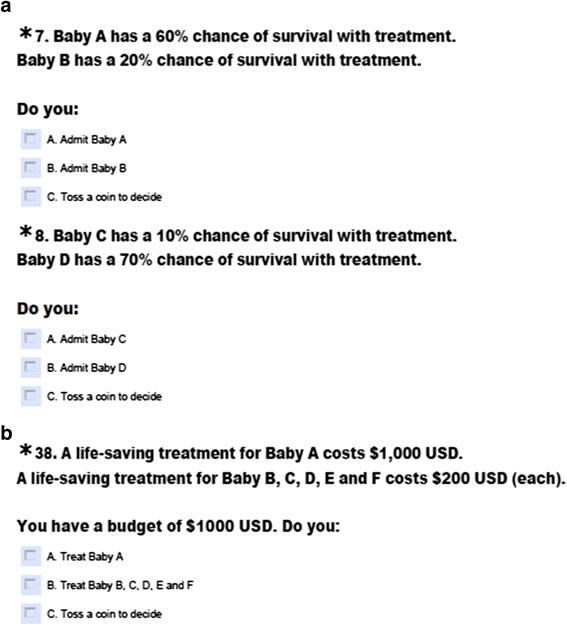The Intensive Care Lifeboat: a survey of lay attitudes to rationing dilemmas in neonatal intensive care
- PMID: 27821118
- PMCID: PMC5100211
- DOI: 10.1186/s12910-016-0152-y
The Intensive Care Lifeboat: a survey of lay attitudes to rationing dilemmas in neonatal intensive care
Abstract
Background: Resuscitation and treatment of critically ill newborn infants is associated with relatively high mortality, morbidity and cost. Guidelines relating to resuscitation have traditionally focused on the best interests of infants. There are, however, limited resources available in the neonatal intensive care unit (NICU), meaning that difficult decisions sometimes need to be made. This study explores the intuitions of lay people (non-health professionals) regarding resource allocation decisions in the NICU.
Methods: The study design was a cross-sectional quantitative survey, consisting of 20 hypothetical rationing scenarios. There were 119 respondents who entered the questionnaire, and 109 who completed it. The respondents were adult US and Indian participants of the online crowdsourcing platform Mechanical Turk. Respondents were asked to decide which of two infants to treat in a situation of scarce resources. Demographic characteristics, personality traits and political views were recorded. Respondents were also asked to respond to a widely cited thought experiment involving rationing.
Results: The majority of respondents, in all except one scenario, chose the utilitarian option of directing treatment to the infant with the higher chance of survival, higher life expectancy, less severe disability, and less expensive treatment. As discrepancy between outcomes decreased, however, there was a statistically significant increase in egalitarian responses and decrease in utilitarian responses in scenarios involving chance of survival (P = 0.001), life expectancy (P = 0.0001), and cost of treatment (P = 0.01). In the classic 'lifeboat' scenario, all but two respondents were utilitarian.
Conclusions: This survey suggests that in situations of scarcity and equal clinical need, non-health professionals support rationing of life-saving treatment based on probability of survival, duration of survival, cost of treatment or quality of life. However, where the difference in prognosis or cost is very small, non-health professionals preferred to give infants an equal chance of receiving treatment.
Keywords: Infant; Intensive care units; Medical ethics; Neonatal; Newborn; Questionnaires; Resource allocation; Resuscitation.
Figures


References
-
- Howson CP, Kinney MV, Lawn JE. Born too soon: the global health action report on preterm birth. Chapter 5. World Health Organization. 2012;16:1–124.
-
- Bawden K, Broadbent R, Cartwright D, et al. Report of the Australian and New Zealand Neonatal Network 2011. 2013.
Publication types
MeSH terms
Grants and funding
LinkOut - more resources
Full Text Sources
Other Literature Sources
Research Materials

